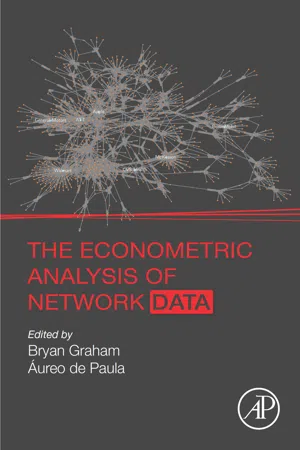
- 244 pages
- English
- ePUB (mobile friendly)
- Available on iOS & Android
The Econometric Analysis of Network Data
About this book
The Econometric Analysis of Network Data serves as an entry point for advanced students, researchers, and data scientists seeking to perform effective analyses of networks, especially inference problems. It introduces the key results and ideas in an accessible, yet rigorous way. While a multi-contributor reference, the work is tightly focused and disciplined, providing latitude for varied specialties in one authorial voice.- Answers both 'why' and 'how' questions in network analysis, bridging the gap between practice and theory allowing for the easier entry of novices into complex technical literature and computation- Fully describes multiple worked examples from the literature and beyond, allowing empirical researchers and data scientists to quickly access the 'state of the art' versioned for their domain environment, saving them time and money- Disciplined structure provides latitude for multiple sources of expertise while retaining an integrated and pedagogically focused authorial voice, ensuring smooth transition and easy progression for readers- Fully supported by companion site code repository- 40+ diagrams of 'networks in the wild' help visually summarize key points
Frequently asked questions
- Essential is ideal for learners and professionals who enjoy exploring a wide range of subjects. Access the Essential Library with 800,000+ trusted titles and best-sellers across business, personal growth, and the humanities. Includes unlimited reading time and Standard Read Aloud voice.
- Complete: Perfect for advanced learners and researchers needing full, unrestricted access. Unlock 1.4M+ books across hundreds of subjects, including academic and specialized titles. The Complete Plan also includes advanced features like Premium Read Aloud and Research Assistant.
Please note we cannot support devices running on iOS 13 and Android 7 or earlier. Learn more about using the app.
Information
Introduction
bUniversity College London, CeMMAP, IFS and CEPR, London, United Kingdom
Abstract
Keywords







Table of contents
- Cover image
- Title page
- Table of Contents
- Copyright
- Preface
- List of contributors
- Chapter 1: Introduction
- Chapter 2: Dyadic regression
- Chapter 3: Strategic network formation
- Chapter 4: Testing for externalities in network formation using simulation
- Chapter 5: Econometric analysis of bipartite networks
- Chapter 6: An empirical model for strategic network formation
- Chapter 7: Econometric analysis of models with social interactions
- Chapter 8: Many player asymptotics for large network formation problems
- Index